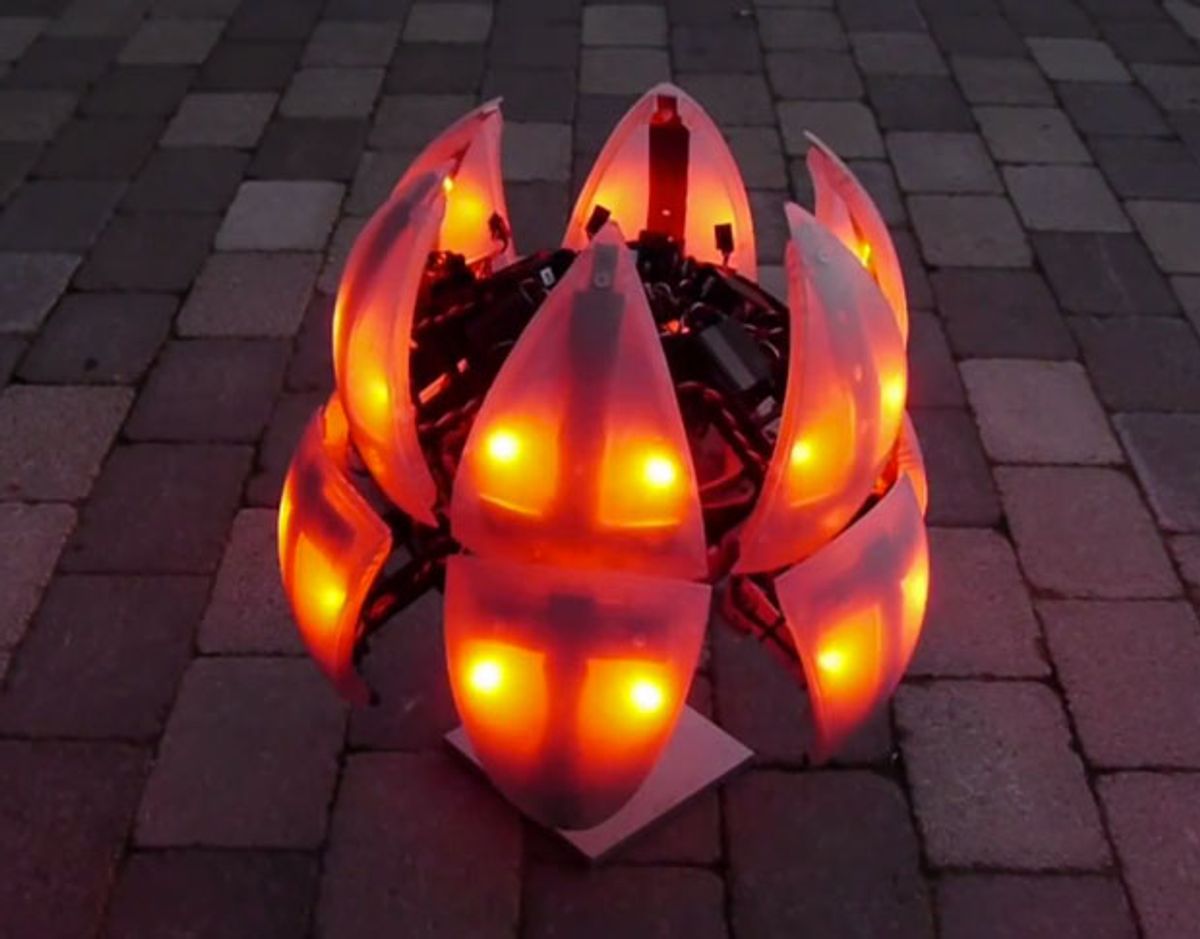Hi there! Welcome to August! I have no idea where you live, but where I live, it's wicked hot out, so how about we just dispense with all of the preamble and video it up directly, yeah? Sound good? Good. Let's do it.
Norwegian robotics genius Kåre Halvorsen (aka Zenta) found a way to make his incredibly awesome MorpHex rolling hexapod/Death Star machine even more incredibly awesomer: an IMU that vastly improves its skill at rolling places.
Oh, and LEDs:
[ Zenta ]
This week, 3D Robotics announced that it had acquired Sifteo, a company that makes clever little computing tiles. This is a bit of an unusual thing, since Sifteo's product has very little to do with robots, and it seems unlikely that the Sifteo cubes are going to suddenly sprout rotors and fly around, as cool as that might be. If you're not familiar, here's what Sifteo cubes are all about:
3D Robotics, meanwhile, makes software and hardware like this:
Put those two things together and what do you get? Probably nothing tangible, unfortunately. From the sound of things, 3D Robotics is more interested in Sifteo's experience and talent (and IP) rather than their products:
Sifteo boasts a consumer acumen proven over years of developing and delivering world-beating customer experiences and shipping high-volume products into mass-scale retailers. The acquisition of the technology and resources specific to Sifteo will further elevate our company’s capabilities on many fronts, and will help propel 3DR into new markets as the industry matures.
Said 3DR CEO Chris Anderson, “When we first engaged with the Sifteo team and saw their skillset, experience, and IP portfolio, we immediately recognized the impact they would have working with us to transform and grow the consumer drone market. Their consumer electronics experience and deep product skills complement our technology perfectly. We are thrilled to have the resources of both groups together to lead what we believe will be a billion dollar market over the next few years.”
[ 3D Robotics ]
Cloud robotics is one of the hottest topics in robotics these days, and the RoboEarth is helping to turn this concept into reality:
This video summarizes the RoboEarth final demonstrator. The demonstrator includes four robots collaboratively working together to help patients in a hospital. These robots used RoboEarth in the following ways:
- a knowledge repository to share and learn from each others' experience
- a communication medium to perform collaborative tasks
- a computational resource to offload some of their heavy computation
[ RoboEarth ]
That car juggling robot concept we had on Video Friday last month is on Kickstarter now, where they're looking for $50,000 to build a one-arm, human-scale prototype:
[ BugJuggler ]
One way to get more range on your drone is to use Parrot's fancy new long-range controller. Another way is to mount a WiFi range extender on the drone itself:
What I don't get, though, is why you'd necessarily need the rotating antenna thingy at all, since rotorcraft can orient themselves arbitrarily in the yaw axis. I guess if you have a camera that's not on a gimbal, maybe that would make sense, but it seems a bit complicated otherwise.
[ NSF ]
There was a bunch of news over the last week or two referring to a "new" ASIMO. As far as we can tell, there isn't a new ASIMO. What seems to have happened is that the latest generation of ASIMO (which, to add to the confusion, Honda calls the "all-new ASIMO") made a debut in Europe, and the ASIMO website was updated with the specs and capabilities of the current model, which was interpreted to mean that a brand new model was released. Some of the flagship features of this "new" ASIMO (which looks exactly the same) include the ability to jump on one foot, understand multiple people talking to it, autonomously avoid people, and perform sign language, all of which are capabilities that we've already seen over the past few years.
Anyway, here's some footage from the European launch; let us know if you spot anything new:
[ ASIMO ]
Robots and humans have very different ways of looking at the world, in that our eyes and brains have physical structures that are not at all alike. Neurala is trying to close that gap with a sensor system that more closely emulates the way our eyes experience the world:
[ Neurala ]
Cheering robots! Nobody ever has to go to live sporting events ever again, hooray!
Via [ BBC ]
Every year, MIT mechanical engineering students in the 2.007 "Design and Manufacturing I" class have a final exam consisting of some sort of very creative competition. This year, they had to build robots capable of traversing a very steep winter Olympics themed course, scoring points of autonomy, ascending slopes, and retrieving medals.
For the more dedicated amongst you, a webcast of the entire competition (three and a half hours worth) can be streamed here.
Personally, I've enjoyed watching this competition ever since I saw it on PBS Scientific American Frontiers with Alan Alda like a decade ago. I've tried to find those vids to embed (because even though they're old, they're tremendously fun to watch), but the best I've been able to come up with is the website of the producers of the show, which hosts them directly. There are two episodes: Season 4 (1993-1994) Episode 3 (Ping Pong Madness starting at 28:30) and Season 12 (2001-2002) Episode 8 (Teetering to Victory starting at 35:30).
[ MIT 2.007 ] via [ Boston Globe ]
Evan Ackerman is a senior editor at IEEE Spectrum. Since 2007, he has written over 6,000 articles on robotics and technology. He has a degree in Martian geology and is excellent at playing bagpipes.



